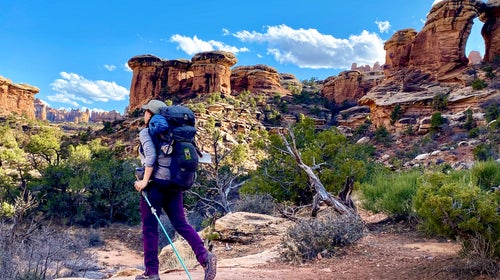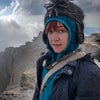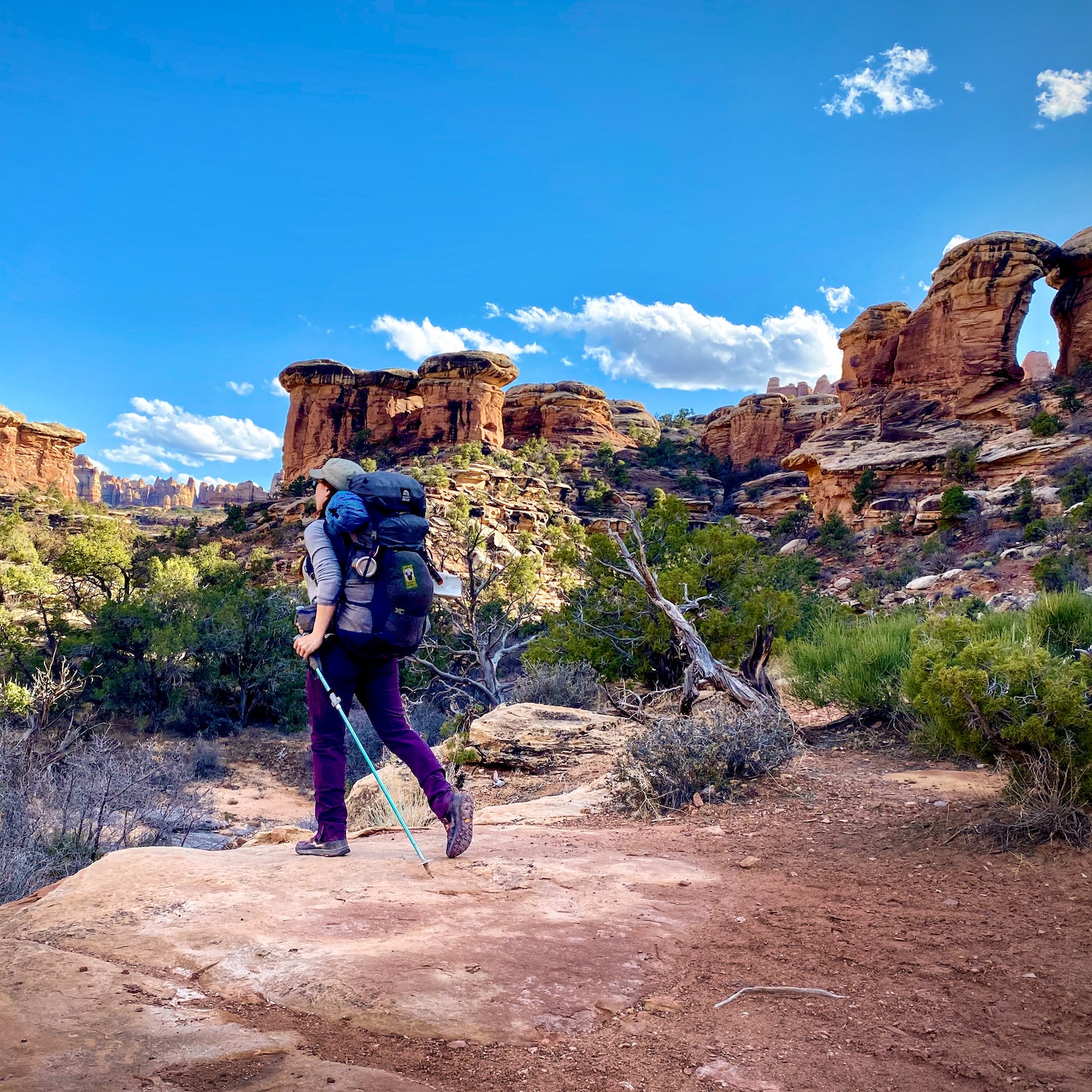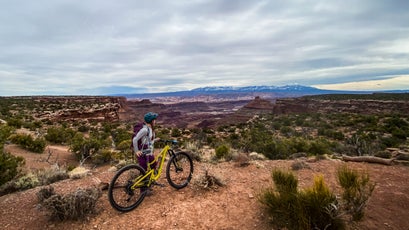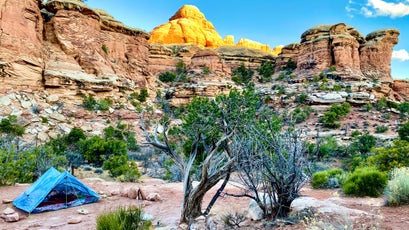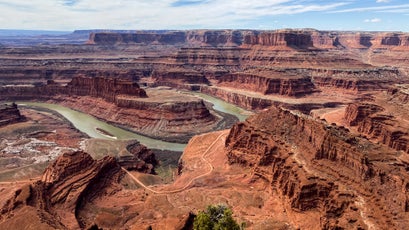62 Parks Traveler┬ástarted with a simple goal: to visit every U.S. national park in one year. Avid backpacker and public-lands nerd┬á┬ásaved up, built out a tiny van to travel and live in, and hit the road. The parks as we know them are rapidly changing, and she┬áwanted to see them before itÔÇÖs too late.
Pennington has returned to traveling and is committed to following CDC guidelines during the COVID-19 pandemic to ensure the safety of herself and others. SheÔÇÖs visiting new parks as they open and closely adhering to best safety practices.
ÔÇťThis is a no-fall ride, so if you see something that looks intense, feel free to walk it,ÔÇŁ our┬ámountain-biking guide told our group. HeÔÇÖs┬áa curly-headed outdoor addict who wanted everyone to have a good time. ÔÇťSlickrock stair climbing on a bike is a uniquely Moab skill set,ÔÇŁ he added. ÔÇťThereÔÇÖs no need to push, dude.ÔÇŁ
It was my first time mountain-biking intermediate trails. A canopy of diffuse, gray clouds hung high overhead and extended all the way to the snowcapped La Sal Mountains, in stark contrast with the burnt tangerine cliffs of Dead Horse Point State Park, which neighbors┬áthis Utah┬ánational park. We set off on an eight-mile loop skirting Canyonland National ParkÔÇÖs grounds, which afforded┬ápanoramic views of its expanse.┬á(Bike tours are also┬áoffered within Canyonlands┬ábut werenÔÇÖt available when I visited, due to the pandemic.). The terrain was rugged and dotted with small junipers as we made our way across Big Chief Trail.
I clicked into a higher gear and tried to balance gracefully on my pedals as the path swerved sharply and into a rocky descent. Hovering my butt just above the saddle, I thanked my lucky stars for the excellent suspension on my loaner bike. My crotch and I survived the journey unscathed.
With the biking adventure behind me, I had to hustle to make the 107-mile drive to the parkÔÇÖs Needles District before sunset. I cranked up the volume on a banjo-heavy playlist and headed┬ásouth, passing mile upon mile of crumbling tablelands.
CanyonlandsÔÇÖ Needles District is known for its otherworldly landscape of bright-orange spires and giant mushrooms of Cedar Mesa sandstone. Hiking amid its formations feels like being plopped right into a desert-themed version of Alice in Wonderland. You feel unusually small as you make your way through┬áthe maze. It takes effort to stay on track and not get lost.
Since I had visited two years prior, this time I wanted to spice things up and go backcountry camping. Alone. I shrugged my fully loaded pack onto my shoulders and nervously made my way up and down the rough-cut sandstone stairs leading into Elephant Canyon.
I shuffled through the Martian terrain, trekking between narrow slits in huge boulders and up a sandy wash before reaching my picture-perfect numbered campsite with no one around for miles. Once my tent was up, I ate a simple dinner among the glowing, fire-red rocks as the sun sank.
The moon was a ribbon-thin waning crescent, and I found the vast dark, with no city lights, almost terrifying to take in. An incessant wind kept my tent flaps vibrating all night. Sleep came intermittently.
When morning dawned, though, the light felt warmer, kinder. I boiled water and sat on a rock, humming softly. IÔÇÖd spent the night on Mars, and yet,┬ásomehow,┬áhere I was, enjoying coffee with my feet firmly on the Earth.
Who needs NASA when youÔÇÖve got Canyonlands?
62 Parks Traveler Canyonlands Info
Size: 337,598 acres
Location: Eastern Utah
Created In: 1964 (national park)
Best For: Backpacking, hiking, mountain biking, four-wheel-drive adventures, geology, river rafting
When to Go: Spring (35 to 82 degrees) and fall (30 to 88 degrees) offer the most temperate weather for those looking to hit the trails. Winters (22 to 52 degrees) are cold but crowd-free. The park is best avoided in summer, when temperatures hover above 100 degrees and monsoon storms can make for dangerous travel.
Where to Stay: Canyonlands National Park has , with assigned, well-spaced campsites available for hikers, bikers, and four-wheel-drive motorists. In the Needles District, backpackers must stay in designated campsites, while other park areas allow visitors to reserve space in an at-large zone.
Where to Eat: in downtown Moab serves a mean turkey panini with a bite-size dessert on the side. The entire menu can be prepared for grab-and-go service, which is perfect for social distancing or outdoor lovers eager to quickly get a move on.
Mini ║┌┴¤│ď╣¤═°: Hike to the edge of Grand View Point. Located at the southern tip of the parkÔÇÖs Island in the Sky District, this destination features┬áa striking, panoramic view of the La Sal Mountains, White Rim Road, and the confluence of the Green and Colorado Rivers. Head along┬áthe accessible, 100-yard paved trail, or traverse the canyonÔÇÖs rim on a relatively flat two-mile round-trip.
Mega ║┌┴¤│ď╣¤═°: Go mountain biking. The area is famous for its slickrock cycling trails and red-rock canyons. in Moab offers a stellar variety of options for every level, from half-day introductory rides to multi-day overnight adventures along the infamous┬áWhite Rim Road (starting at $105).
